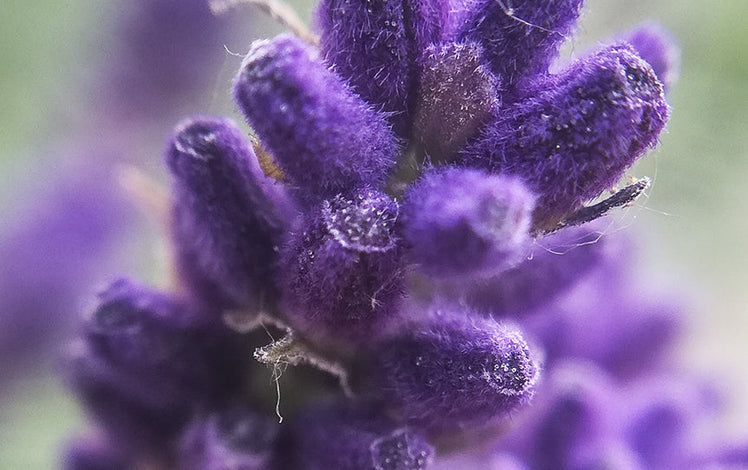Calming, soothing, versatile – and the source of one of the most loved essential oils.
Plant name (Latin): Lavandula angustifolia
Plant family: Lamiaceae (mint family)
Native region: Warm, sunny areas of the Mediterranean
Growing habit: Medium height shrub with narrow, needle-like leaves and pinkish-purple flowers
Parts used: Flowers and leaves
Essential oil extraction method: Steam distillation of the flowers
About Lavender Oil
Lavender, a fragrant, pale purple flower with a soothing scent, has been used for healing, cleaning, cooking, beauty and fragrance for thousands of years. Floral and herbaceous, lavender’s history of use even includes a legend that it was used to tame tigers and bears. In essential oil blends, it works as an adaptogen to increase the effectiveness of other essential oils.

Why Use Lavender Oil
Floral and herbaceous, lavender is loved for its whole-body calming and balancing benefits. This sweet essential oil is commonly used alone and is featured in many of our relaxing blends.
How and Where Lavender Grows
Lavender is a beautifully fragrant shrub that can grow up to 1 to 2 metres tall (3.3 to 6.6 feet). It has narrow, evergreen needles and pinkish-purple (which is why that shade is known as ‘lavender’) that appear on spikes at the top of long, leafless stems.
Lavender is native to the Mediterranean region, and grows best in climates with sunny, dry summers and wet winters, but it can grow in a wide range of conditions. France is well known for its fragrant purple fields of lavender, but in 2014, Bulgaria surpassed France in commercial lavender production for the first time. Other major world producers include Spain, the Baltic countries and Australia.
Even though England does not have a Mediterranean climate, lavender grows very well in the region and is commonly planted in English gardens. From the Middle Ages until well into the Victorian era, England had a thriving lavender industry centered around Mitcham, Surrey. When London’s growth started to take over surrounding farmland, the industry disappeared. Today, lavender is still grown commercially in Norfolk, in fields that were originally planted to meet the demand for lavender in World War I after the Mitcham industry declined.
While commercial production of lavender is generally limited to warmer countries, lavender is planted successfully in gardens around the world. Lavender is generally hardy to USDA zone 5 (where extreme winter temperatures don’t get colder than -15 to -20 degrees Celsius, or -28 degrees Fahrenheit). It is very drought-tolerant, and prefers well-drained soil.
The Many Uses of Lavender
EDIBLE LAVENDER
Lavender is a member of the mint family, and can be used in cooking. However, while all lavender is technically edible, not all varieties will taste good in your food! The main lavender varieties used in cooking are English Lavender (lavandula angustifolias) and Provence Lavender (sometimes called lavandin). English Lavender is sweeter, and is used for cookies, jams and teas, while Provence Lavender is used in the savoury spice mixture herbs de Provence (frequently used in French cuisine).
Other lavender varieties might taste too harsh and medicinal for culinary use. Before creating food with lavender, be sure to buy a variety of the herb that’s specifically marked for culinary use. It will have been grown and packaged to ensure that it’s safe (and tasty) to eat.
LAVENDER ESSENTIAL OIL
Loved by many for its soothing, calming effect on the mind and body, lavender can also be used as a carrier oil in essential oil blends. Essential oil blends containing lavender can be used in an ultrasonic diffuser to add a calming, freshening element to your indoor environment. To keep linens and other fabrics fresh, add a few drops of lavender essential oil to your laundry’s rinse cycle. You can even add some drops to dryer balls so that your laundry comes out of the dryer smelling like an English garden.
Lavender Oil in Ayurveda
Lavender is considered to have benefits to all three doshas: vata, pitta and kapha. Lavender is considered to have a calming, cooling and soothing energy which will calm kapha and pitta doshas and stimulate the vata dosha. According to Ayurvedic teachings, lavender oil is particularly useful for:
- Enhancing prana, or the vital life force
- Nourishing hair and skin
- Calming the mind and relaxing the nerves
Lavender essential oil can be used in the Ayurvedic treatment Shirodhara, in which sesame oil is blended with essential oils, then dropped onto the forehead (and seat of the sixth chakra).
The Symbolism of Lavender
The name lavender comes from the Latin lavare, "to wash," because the herb was often used in bath and laundry waters and soaps, and still is. Throughout the centuries, lavender has been used to scent love letters and as a perfume to attract a love interest. It was also used in ancient times to tame tigers and bears.
Lavender is sometimes associated with the planet Mercury; with the element of air; and with the astrological signs Gemini and Virgo. Purple, the colour of lavender blooms, is associated with the crown chakra, which is the energy centre associated with higher purpose and spiritual connectivity.
For thousands of years, lavender has been used to scent spiritual places and religious ceremonies. The “magical” properties of lavender are even mentioned in the popular book and movie, Practical Magic: “There are some things, after all, that Sally Owens knows for certain: Always throw spilled salt over your left shoulder. Keep rosemary by your garden gate. Add pepper to your mashed potatoes. Plant roses and lavender, for luck. Fall in love whenever you can.” ― Alice Hoffman
The History of Lavender

Lavender has been used for at least 2,500 years, and was well known in the ancient world. The Egyptians used lavender for cosmetics and as part of their embalming rituals. The Romans used lavender for many things, including laundry, scenting rooms, dressing burns and other wounds, in cooking, and in beauty rituals.
The Hebrews called lavender spikenard or simply nard, and included it in the recipe for holy essens in Hebrew temples. The floral herb is also mentioned in the Song of Solomon. The Greek philosopher Diogenes felt that the Egyptian practice of putting lavender oil on the head wasted the benefits of the enticing smell, and said: “When you anoint your head with perfume, it flies away in the air and birds only get the benefit of it, whilst if I rub it on my lower limbs it envelopes my whole body and gratefully ascends to my nose.”
Lavender continued to be widely used in medieval and renaissance Europe. In the 12th Century, the herbalist and nun St. Hildegard of Bingen used lavender to make wine, and wrote about lavender in her books on healing herbs. In 16th century France, glove makers scented their creations with lavender. Glovemakes also seemed to escape some of the terrible infections of the time, such as plague and cholera.
Queen Elizabeth I was known to drink lavender tea to help ease her migraines, and by the 17th Century, lavender was noted as cure-all across most of Europe. Lavender prices spiked during the Great Plague of 1665, as it was believed that lavender would protect against the disease. Grave diggers (and a few graverobbers) washed plague victims’ belonging in a lavender solution. By Victorian times, lavender was widely cultivated in England, and lavender was used for cooking, cleaning, scenting homes, and in cosmetics and skin treatments. Mitcham, England, became a world-renowned centre of lavender production.
The Science of Lavender Oil
By 1910, French chemist and scholar René-Maurice Gattefossé is reported to have discovered the healing virtues of lavender. In his book, Aromatherapie, he explains that after a laboratory experiment gone wrong that resulted in gangrenous sores on his hand, an application of lavender essential oil started healing the wounds right away.
Gattefossé’s discovery of the benefits of lavender oil and other essential oils lead to the use of lavender and other oils in military hospitals during World War I. Since then, lavender essential oil has continued to be used for its beautiful aroma, and its cleansing, healing, and relaxing properties.

